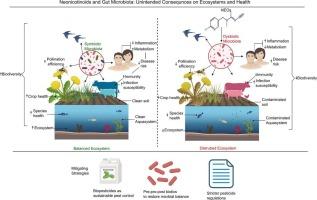新烟碱类杀虫剂的附带损害:对非目标生物肠道微生物群的意外影响
IF 4.3
3区 环境科学与生态学
Q2 BIOCHEMISTRY & MOLECULAR BIOLOGY
Comparative Biochemistry and Physiology C-toxicology & Pharmacology
Pub Date : 2025-08-18
DOI:10.1016/j.cbpc.2025.110330
引用次数: 0
摘要
新烟碱类(NEOs)是一种广泛使用的杀虫剂,以其有效的害虫防治而闻名。然而,人们对它们在环境中的持久性和对非目标生物,特别是肠道微生物群的意外影响感到担忧。肠道菌群对消化、免疫和代谢健康至关重要,可被neo破坏,导致生态失调、免疫功能障碍、代谢紊乱和对感染的易感性增加。近地天体暴露已被证明会减少蜜蜂、啮齿动物和人类等物种的微生物多样性,尤其是有益细菌。这种破坏会导致炎症、胃肠道紊乱和全身性疾病。本综述比较了包括吡虫啉、噻虫嗪和噻虫胺在内的各种neo对不同物种肠道微生物群的影响。它强调了对微生物群落的有害影响,特别是对蜜蜂等传粉媒介的有害影响,并延伸到脊椎动物和水生生物。肠道菌群的破坏可能导致严重的生态后果,包括授粉受损、植物健康下降和生态系统恢复能力受损。迫切需要进一步的研究来了解neo诱导的微生物群破坏背后的机制,并开发可持续的害虫管理替代方案。它提倡更严格的法规,开发生物农药,并使用益生菌来减轻肠道微生物群的破坏。通过全面研究和监管措施解决这些问题对于保护非目标生物、生态系统和公众健康免受neo意外附带损害至关重要。本文章由计算机程序翻译,如有差异,请以英文原文为准。

Collateral damage of neonicotinoid insecticides: Unintended effects on gut microbiota of non-target organisms
Neonicotinoids (NEOs) are widely used insecticides known for their effectiveness in pest control. However, concerns have emerged regarding their persistence in the environment and unintended effects on non-target organisms, particularly gut microbiota. The gut microbiota, essential for digestion, immunity, and metabolic health, can be disrupted by NEOs, leading to dysbiosis, immune dysfunction, metabolic disturbances, and increased susceptibility to infections. NEO exposure has been shown to reduce microbial diversity, particularly beneficial bacteria, in species like honeybees, rodents, and humans. This disruption can contribute to conditions such as inflammation, gastrointestinal disorders, and systemic diseases. This review compares the effects of various NEOs, including imidacloprid, thiamethoxam, and clothianidin, on gut microbiota across species. It highlights the detrimental impact on microbial communities, particularly in pollinators like bees, and extends to vertebrates and aquatic organisms. The disruption of gut microbiota can lead to severe ecological consequences, including impaired pollination, reduced plant health, and compromised ecosystem resilience. There is an urgent need for further research to understand the mechanisms behind NEO-induced microbiota disruption and to develop sustainable pest management alternatives. It advocates for stricter regulations, the development of biopesticides, and the use of probiotics to mitigate gut microbiota disruption. Addressing these issues through comprehensive studies and regulatory measures is crucial to protect non-target organisms, ecosystems, and public health from the unintended collateral damage of NEOs.
求助全文
通过发布文献求助,成功后即可免费获取论文全文。
去求助
来源期刊
CiteScore
7.50
自引率
5.10%
发文量
206
审稿时长
30 days
期刊介绍:
Part C: Toxicology and Pharmacology. This journal is concerned with chemical and drug action at different levels of organization, biotransformation of xenobiotics, mechanisms of toxicity, including reactive oxygen species and carcinogenesis, endocrine disruptors, natural products chemistry, and signal transduction with a molecular approach to these fields.

 求助内容:
求助内容: 应助结果提醒方式:
应助结果提醒方式:


